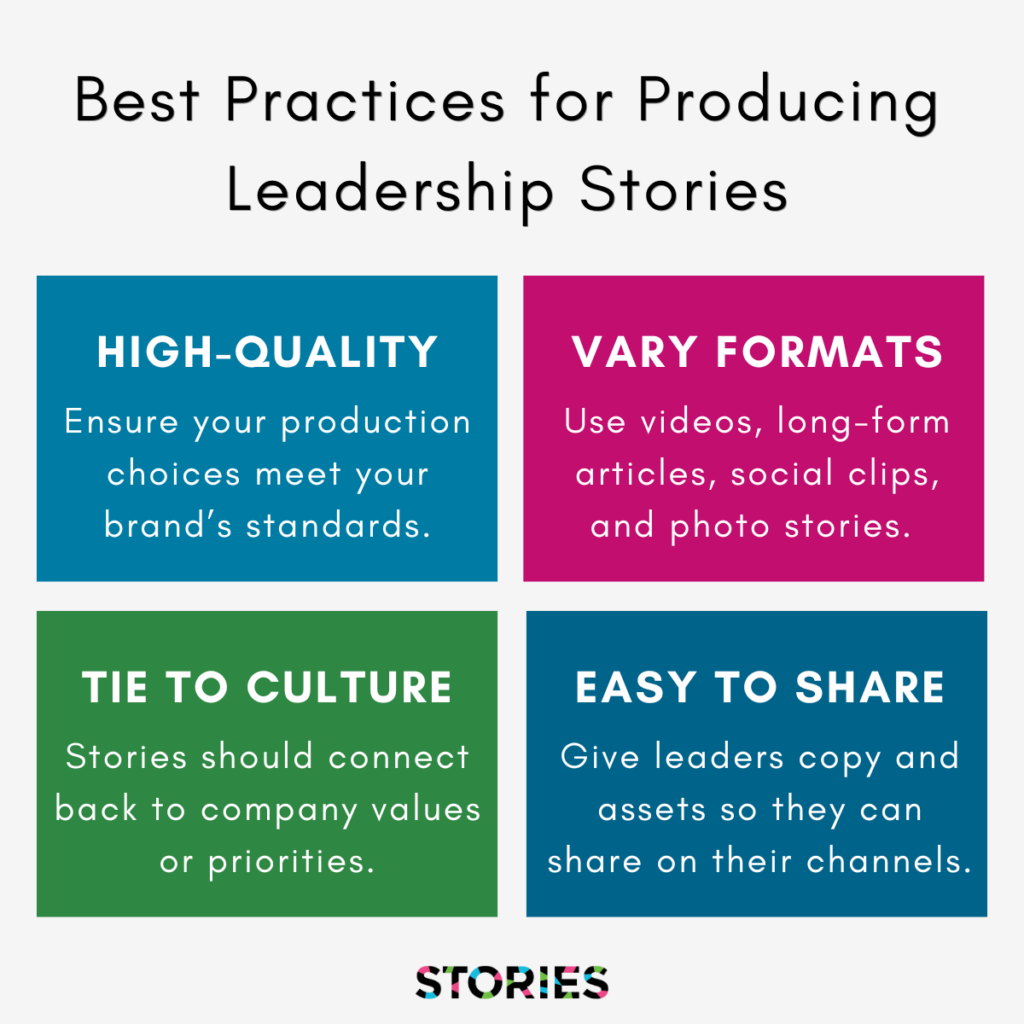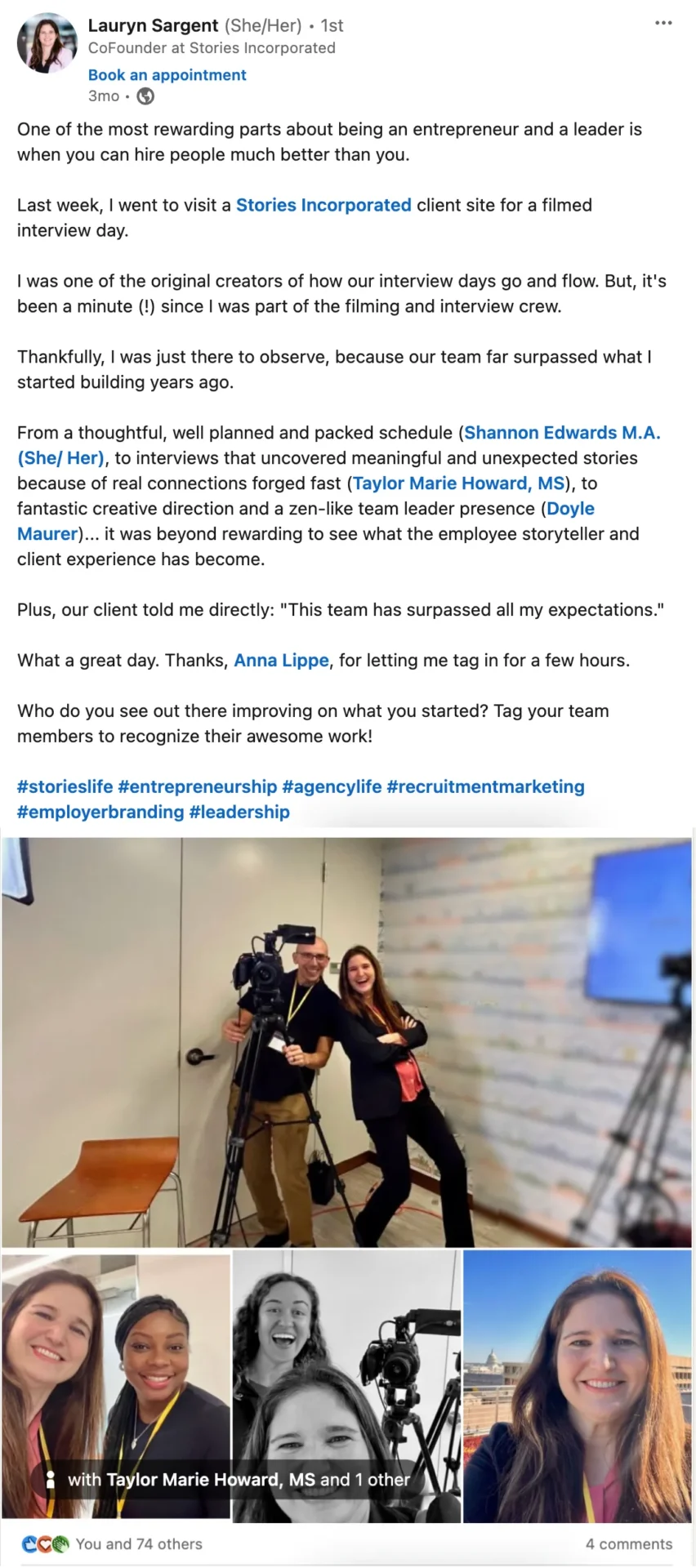How to Create a Leadership Story Series
Your leaders are some of your most effective brand ambassadors, recruiters, and company culture champions. A well-crafted leadership story series brings their experiences, insights, and values to a wide audience—prospective employees, customers, or internal teams.
There’s never been a better opportunity to showcase your leaders while strengthening your employer brand. Especially during times of uncertainty, leadership stories humanize executives, build trust, and communicate culture in a powerful way.
Here’s how to create a leadership story series that resonates across multiple platforms.
What is a Leadership Story Series?
A leadership story series is a collection of content—videos, articles, interviews, social posts, and more—designed to highlight a leader’s perspective, career journey, and connection to company culture. The stories are shared over time and can be distributed through multiple channels, including company blogs, newsletters, podcasts, industry events, and social media like LinkedIn.
Authentic leadership storytelling builds engagement, fosters trust, and showcases company values in action.
In this post, we’ll explore how to create your leadership series in four steps.
Step One: Select Your Leader Storytellers
Not all leaders need to be extroverted or charismatic to tell great stories. The key is finding those with compelling experiences that align with your company’s mission and culture.
Here are a few ways to identify strong leaders for your series:
- Leaders who “grew up” in the company or industry – Their career journeys provide relatable, aspirational stories for employees and candidates. We like this story from Mike, who grew up in the automotive industry and is now a senior leader:
- Leaders driving major company initiatives – Their perspectives naturally align with key business priorities and employer brand messaging.
- Leaders with something to gain – Whether launching a new program, hiring for their team, or stepping into a bigger role, they have a vested interest in sharing their experiences.
- Leaders who value team recognition – Many leaders feel uncomfortable sharing personal achievements but framing stories around team success makes storytelling more natural.
- Leaders who love the company and culture – Passionate leaders make compelling storytellers, reinforcing company values through personal anecdotes.
In the example below from Stories Inc. co-founder Lauryn Sargent, she uses a LinkedIn post to recognize team members for a job well done:
Step Two: Make Storytelling Easy for Leaders
Many leaders hesitate to share their experiences because they don’t know what to say or feel self-conscious. A structured process makes it easier for them to participate while ensuring high-quality storytelling in whatever way you capture their stories.
Here are ways to encourage leaders to share their stories:
- Facilitate interviews – A conversational approach helps leaders articulate their experiences naturally.
- Leverage existing leadership events – Capture stories during leadership retreats, company all-hands meetings, or industry conferences for minimal disruption to their normal schedules.
- Emphasize real, personal stories – The best content is authentic and relatable, not rehearsed corporate messaging. Show them what good looks like by sharing other leader stories.
- Help them feel prepared – Provide a short prep call before interviews to build confidence and establish rapport before asking for their stories.
Step Three: Create High-Quality Content
Once you’ve captured leadership stories, focus on producing content that is visually engaging, informative, and aligned with your company’s branding.

Step Four: Maximize Visibility Across Platforms
A leadership story series should not be limited to a single platform. Maximize impact by distributing content across multiple channels:
- Company website and blog – Feature leadership spotlight videos and Q&A articles.
- YouTube and Instagram Reels – Post video interviews and behind-the-scenes content.
- Podcasts – Highlight leadership stories in an audio format. Pro tip: Wait to launch until you have 5-10 leader interviews so you can publish as a series to maximize listener engagement.
- Newsletters – Share stories internally and externally to keep employees and stakeholders engaged.
- Company social media – Repurpose content into bite-sized insights that reach broader audiences. Be sure to tag the leader profiled.
- Leaders’ social media – Give each leader an easy-to-use library of social content they can post to LinkedIn or their other social media accounts.
Bonus Step Five: Activate Your Leaders on Social, Too
Sharing leader stories on your branded channels is a great first step in communicating culture. But, you can take it a step further by helping to activate your leaders on their own accounts, too.
Building an engaged audience takes time. Even leaders with large networks won’t see an immediate impact unless they share stories consistently on their channels. Once you have a leader bought into sharing their stories on their channels, you can help them activate in a meaningful and easy way.
Here’s how to maintain momentum with an individual leader:
- Plan a content calendar for them – From a single interview, you can generate multiple content pieces over weeks or months. Guide them on the best times to share each piece.
- Vary content formats – Mix up video clips, written articles, image-based posts, and short quotes.
- Encourage engagement – Leaders should respond to comments, share insights, and interact with their audience to build connections when they post content to their accounts.
Bring Leadership Stories to Life
Leadership storytelling is one of the most effective ways to humanize your brand, engage employees, and attract top talent. A well-executed leadership story series ensures your leaders’ voices are heard across multiple platforms, reinforcing company culture and inspiring audiences.
Need help crafting and distributing leadership stories? Stories Inc. specializes in uncovering and sharing authentic leadership narratives that elevate employer brands. Get in touch to learn how we can help.


